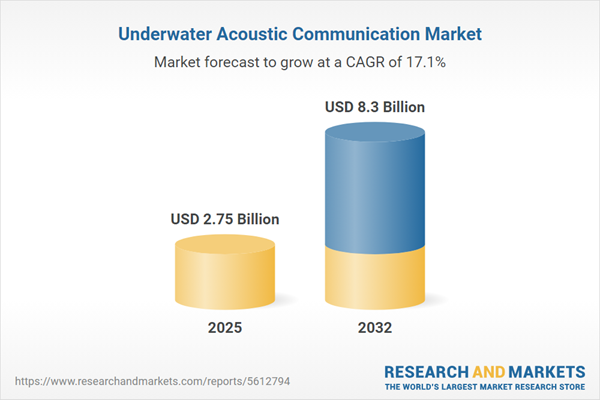Speak directly to the analyst to clarify any post sales queries you may have.
Underwater acoustic communication is transforming how maritime organizations manage subsea data exchange, creating a resilient foundation for defense, energy, and scientific operations in challenging environments.
Market Snapshot: Underwater Acoustic Communication Market
The Underwater Acoustic Communication Market grew from USD 2.34 billion in 2024 to USD 2.75 billion in 2025. It is projected to advance at a compound annual growth rate (CAGR) of 17.12%, reaching USD 8.30 billion by 2032.
This expansion is fueled by surging adoption of autonomous underwater vehicles, deeper offshore exploration, and an emphasis on robust subsea network connectivity. The market’s trajectory reflects rising demand for reliable subsea communications solutions across commercial, defense, and environmental monitoring sectors worldwide.Scope & Segmentation of the Underwater Acoustic Communication Market
This report delivers a comprehensive analysis spanning leading technologies, platforms, applications, and regional dynamics, addressing key strategic questions for senior decision-makers.
- Product Types: Modems for advanced multiuser network topologies; Sensors that enable deployment on unmanned platforms; Analog and digital Transceivers supporting both long-range and high-efficiency data transmissions.
- Platforms: Autonomous underwater vehicles serving mission-critical data needs; Buoys functioning as relay nodes; Fixed stations for persistent monitoring; Mobile vessels designed for rapid data transfer.
- Frequencies: High frequency for greater data rates over short ranges; Low and medium frequencies suited for longer range and wider network coverage.
- Depths: Shallow deployments designed for cost-effective inspections; Mid-depth networks emphasizing reliability; Deep operations requiring enhanced environmental resilience.
- Applications: Commercial (such as subsea tourism and resource extraction); Defense (custom solutions for maritime security); Environmental monitoring (ecosystem tracking); Oil & Gas (real-time asset monitoring); Scientific research (multinode experimentation and surveying).
- Regions Covered:
- Americas (United States, Canada, Mexico, Brazil, Argentina, Chile, Colombia, Peru)
- Europe, Middle East & Africa (UK, Germany, France, Russia, Italy, Spain, Netherlands, Sweden, Poland, Switzerland, UAE, Saudi Arabia, Qatar, Turkey, Israel, South Africa, Nigeria, Egypt, Kenya)
- Asia-Pacific (China, India, Japan, Australia, South Korea, Indonesia, Thailand, Malaysia, Singapore, Taiwan)
- Leading Companies: Teledyne Technologies Incorporated, Kongsberg Gruppen ASA, General Dynamics Corporation, L3Harris Technologies, Lockheed Martin, Raytheon Technologies, Sonardyne International, ECA Group SAS, Thales S.A., EvoLogics GmbH.
Key Takeaways for Senior Leaders
- Recent technological advances are reshaping underwater communication networks, with digital signal processing and machine learning delivering adaptive channel performance even in noisy and variable environments.
- Industry leaders are adopting modular and open architectures, enhancing system interoperability and facilitating integration with a broad mix of platforms and vendors.
- Environmental imperatives are guiding product design, with manufacturers prioritizing energy-efficient materials and eco-friendly configurations for compliance and competitive differentiation.
- The shift to managed communication networks as a service is realigning vendor relationships, providing end users with flexible, scalable options for long-term operational support.
- Regional investments in naval modernization, offshore energy, and maritime security are accelerating the deployment of sophisticated acoustic networks across the Americas, EMEA, and Asia-Pacific.
Impact of 2025 United States Tariffs
U.S. tariff adjustments in 2025 have disrupted global supply chains for underwater acoustic communication, particularly affecting sourcing of piezoelectric and precision electronic components. In response, industry participants are diversifying supply bases and investing in localized assembly to mitigate cost pressures and uphold delivery timelines. Providers have introduced incremental upgrade pathways to help clients manage total cost of ownership and address fluctuating input costs.
Methodology & Data Sources
This report utilizes a robust methodology combining primary interviews with key industry stakeholders—engineers, procurement leads, and product managers—and thorough review of peer-reviewed journals and market studies. Regional and segmental findings are cross-validated through consultation with logistics providers, recent deployment case studies, and expert peer reviews, ensuring insight reliability.
Why This Report Matters
- Decision-makers gain trusted insight into technology trends, regional opportunities, and market risks to guide strategic planning and capital allocation.
- Comprehensive segmentation details enable precise benchmarking and align product portfolios with current and emerging user needs.
- The report supports procurement teams with timely analysis of geopolitical disruptions and evolving tariff landscapes, enhancing supply chain resilience.
Conclusion
With its thorough segmentation, global perspective, and focus on actionable strategies, this report empowers leaders to capitalize on emerging growth in underwater acoustic communication. Stakeholders who prioritize adaptability and sustainability will be best positioned amid continued industry evolution.
Additional Product Information:
- Purchase of this report includes 1 year online access with quarterly updates.
- This report can be updated on request. Please contact our Customer Experience team using the Ask a Question widget on our website.
Table of Contents
3. Executive Summary
4. Market Overview
7. Cumulative Impact of Artificial Intelligence 2025
Companies Mentioned
The companies profiled in this Underwater Acoustic Communication market report include:- Teledyne Technologies Incorporated
- Kongsberg Gruppen ASA
- General Dynamics Corporation
- L3Harris Technologies, Inc.
- Lockheed Martin Corporation
- Raytheon Technologies Corporation
- Sonardyne International Ltd.
- ECA Group SAS
- Thales S.A.
- EvoLogics GmbH
Table Information
| Report Attribute | Details |
|---|---|
| No. of Pages | 197 |
| Published | October 2025 |
| Forecast Period | 2025 - 2032 |
| Estimated Market Value ( USD | $ 2.75 Billion |
| Forecasted Market Value ( USD | $ 8.3 Billion |
| Compound Annual Growth Rate | 17.1% |
| Regions Covered | Global |
| No. of Companies Mentioned | 11 |









